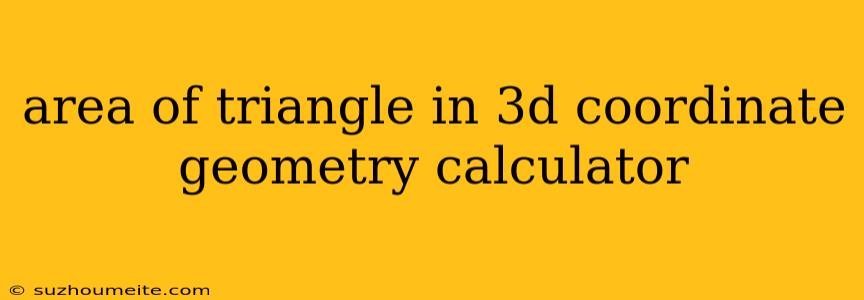Area of a Triangle in 3D Coordinate Geometry
In 3D coordinate geometry, finding the area of a triangle is a bit more complex than in 2D. However, with the right formulas and understanding of vectors, it becomes quite manageable.
Understanding the Concept
The area of a triangle is half the magnitude of the cross product of two vectors representing two sides of the triangle.
Formula
Let's say we have a triangle with vertices A(x<sub>1</sub>, y<sub>1</sub>, z<sub>1</sub>), B(x<sub>2</sub>, y<sub>2</sub>, z<sub>2</sub>), and C(x<sub>3</sub>, y<sub>3</sub>, z<sub>3</sub>).
-
Find two vectors representing two sides of the triangle:
- AB = (x<sub>2</sub> - x<sub>1</sub>, y<sub>2</sub> - y<sub>1</sub>, z<sub>2</sub> - z<sub>1</sub>)
- AC = (x<sub>3</sub> - x<sub>1</sub>, y<sub>3</sub> - y<sub>1</sub>, z<sub>3</sub> - z<sub>1</sub>)
-
Calculate the cross product of these two vectors:
- AB x AC = ( (y<sub>2</sub> - y<sub>1</sub>)(z<sub>3</sub> - z<sub>1</sub>) - (z<sub>2</sub> - z<sub>1</sub>)(y<sub>3</sub> - y<sub>1</sub>), (z<sub>2</sub> - z<sub>1</sub>)(x<sub>3</sub> - x<sub>1</sub>) - (x<sub>2</sub> - x<sub>1</sub>)(z<sub>3</sub> - z<sub>1</sub>), (x<sub>2</sub> - x<sub>1</sub>)(y<sub>3</sub> - y<sub>1</sub>) - (y<sub>2</sub> - y<sub>1</sub>)(x<sub>3</sub> - x<sub>1</sub>) )
-
Find the magnitude of the cross product:
- |AB x AC| = √( ( (y<sub>2</sub> - y<sub>1</sub>)(z<sub>3</sub> - z<sub>1</sub>) - (z<sub>2</sub> - z<sub>1</sub>)(y<sub>3</sub> - y<sub>1</sub>) )<sup>2</sup> + ( (z<sub>2</sub> - z<sub>1</sub>)(x<sub>3</sub> - x<sub>1</sub>) - (x<sub>2</sub> - x<sub>1</sub>)(z<sub>3</sub> - z<sub>1</sub>) )<sup>2</sup> + ( (x<sub>2</sub> - x<sub>1</sub>)(y<sub>3</sub> - y<sub>1</sub>) - (y<sub>2</sub> - y<sub>1</sub>)(x<sub>3</sub> - x<sub>1</sub>) )<sup>2</sup> )
-
Divide the magnitude by 2 to get the area of the triangle:
- Area of triangle ABC = (1/2) * |AB x AC|
Example
Let's say we have a triangle with vertices A(1, 2, 3), B(4, 5, 6), and C(7, 8, 9).
-
Find the vectors AB and AC:
- AB = (4 - 1, 5 - 2, 6 - 3) = (3, 3, 3)
- AC = (7 - 1, 8 - 2, 9 - 3) = (6, 6, 6)
-
Calculate the cross product of AB and AC:
- AB x AC = ( (3)(6) - (3)(6), (3)(6) - (3)(6), (3)(6) - (3)(6) ) = (0, 0, 0)
-
Find the magnitude of the cross product:
- |AB x AC| = √(0<sup>2</sup> + 0<sup>2</sup> + 0<sup>2</sup>) = 0
-
Divide the magnitude by 2 to get the area of the triangle:
- Area of triangle ABC = (1/2) * 0 = 0
In this case, the area of the triangle is 0. This means that the three points A, B, and C are collinear, forming a line segment instead of a triangle.
Calculator
You can use various online calculators and software programs to calculate the area of a triangle in 3D coordinate geometry. These calculators often provide a user-friendly interface where you can input the coordinates of the vertices, and the calculator will automatically perform the calculations and display the area.
Remember that these calculators are tools to simplify the process, but understanding the underlying concepts is crucial for applying them correctly and interpreting the results.
